
The World Food Programme (WFP) is an international organization within the United Nations that provides food assistance worldwide. It is the world's largest humanitarian organization and the leading provider of school meals. Founded in 1961, WFP is headquartered in Rome and has offices in 80 countries. As of 2021, it supported over 128 million people across more than 120 countries and territories.
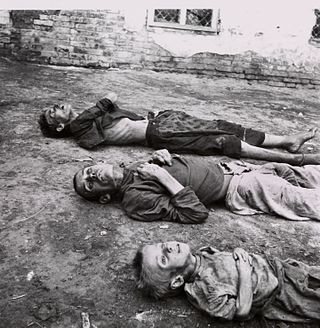
A famine is a widespread scarcity of food, caused by several possible factors, including war, natural disasters, crop failure, widespread poverty, an economic catastrophe or government policies. This phenomenon is usually accompanied or followed by regional malnutrition, starvation, epidemic, and increased mortality. Every inhabited continent in the world has experienced a period of famine throughout history. During the 19th and 20th century, Southeast and South Asia, as well as Eastern and Central Europe, suffered the greatest number of fatalities. Deaths caused by famine declined sharply beginning in the 1970s, with numbers falling further since 2000. Since 2010, Africa has been the most affected continent in the world by famine.

Food security is the state of having reliable access to a sufficient quantity of affordable, nutritious food. The availability of food for people of any class, gender or religion is another element of food security. Similarly, household food security is considered to exist when all the members of a family, at all times, have access to enough food for an active, healthy life. Individuals who are food-secure do not live in hunger or fear of starvation. Food security includes resilience to future disruption of food supply. Such a disruption could occur due to various risk factors such as droughts and floods, shipping disruptions, fuel shortages, economic instability, and wars. Food insecurity is the opposite of food security: a state where there is only limited or uncertain availability of suitable food.
Famine relief is an organized effort to reduce starvation in a region in which there is famine. A famine is a phenomenon in which a large proportion of the population of a region or country are so undernourished that death by starvation becomes increasingly common. In spite of the much greater technological and economic resources of the modern world, famine still strikes many parts of the world, mostly in the developing nations.
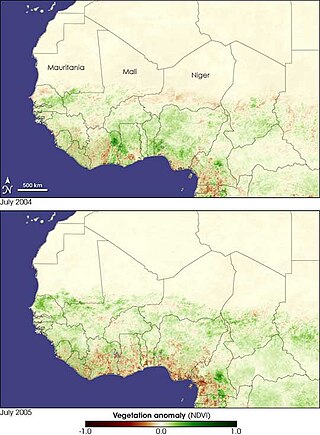
The 2005–2006 Niger food crisis was a severe but localized food security crisis in the regions of northern Maradi, Tahoua, Tillabéri, and Zinder of Niger from 2005 to 2006. It was caused by an early end to the 2004 rains, desert locust damage to some pasture lands, high food prices, and chronic poverty. In the affected area, 2.4 million of 3.6 million people are considered highly vulnerable to food insecurity. An international assessment stated that, of these, over 800,000 face extreme food insecurity and another 800,000 in moderately insecure food situations are in need of aid.
Famine scales are metrics of food security going from entire populations with adequate food to full-scale famine. The word "famine" has highly emotive and political connotations and there has been extensive discussion among international relief agencies offering food aid as to its exact definition. For example, in 1998, although a full-scale famine had developed in southern Sudan, a disproportionate amount of donor food resources went to the Kosovo War. This ambiguity about whether or not a famine is occurring, and the lack of commonly agreed upon criteria by which to differentiate food insecurity has prompted renewed interest in offering precise definitions. As different levels of food insecurity demand different types of response, there have been various methods of famine measurement proposed to help agencies determine the appropriate response.

Malawi is one of the world's undeveloped countries and is ranked 170 out of 187 countries according to the 2010 Human Development Index. It has about 16 million people, 53% of whom live under the national poverty line and 90% of whom live on less than $2 per day.
In different administrative and organizational forms, the Food for Peace program of the United States has provided food assistance around the world for more than 60 years. Approximately 3 billion people in 150 countries have benefited directly from U.S. food assistance. The Bureau for Humanitarian Assistance within the United States Agency for International Development (USAID) is the U.S. Government's largest provider of overseas food assistance. The food assistance programming is funded primarily through the Food for Peace Act. The Bureau for Humanitarian Assistance also receives International Disaster Assistance Funds through the Foreign Assistance Act (FAA) that can be used in emergency settings.
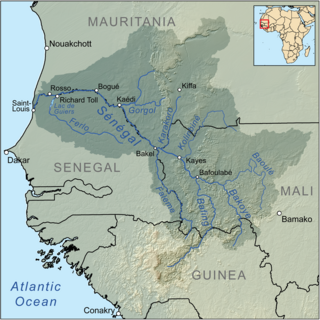
A large-scale, drought-induced famine occurred in Africa's Sahel region and many parts of the neighbouring Sénégal River Area from February to August 2010. It is one of many famines to have hit the region in recent times.

Food security is defined, according to the World Food Summit of 1996, as existing "when all people at all times have access to sufficient, safe, nutritious food to maintain a healthy and active life". This commonly refers to people having "physical and economic access" to food that meets both their nutritional needs and food preferences. Today, Ethiopia faces high levels of food insecurity, ranking as one of the hungriest countries in the world, with an estimated 5.2 million people needing food assistance in 2010. Ethiopia was ranked 92 in the world in Global Hunger Index 2020.

Occurring between July 2011 and mid-2012, a severe drought affected the entire East African region. Said to be "the worst in 60 years", the drought caused a severe food crisis across Somalia, Djibouti, Ethiopia and Kenya that threatened the livelihood of 9.5 million people. Many refugees from southern Somalia fled to neighboring Kenya and Ethiopia, where crowded, unsanitary conditions together with severe malnutrition led to a large number of deaths. Other countries in East Africa, including Sudan, South Sudan and parts of Uganda, were also affected by a food crisis.

There were 795 million undernourished people in the world in 2014, a decrease of 216 million since 1990, despite the fact that the world already produces enough food to feed everyone—7 billion people—and could feed more than that—12 billion people.
Since 2016, a food insecurity crisis has been ongoing in Yemen which began during the Yemeni Civil War. The UN estimates that the war has caused an estimated 130,000 deaths from indirect causes which include lack of food, health services, and infrastructure as of December 2020. In 2018, Save the Children estimated that 85,000 children have died due to starvation in the three years prior. In May 2020, UNICEF described Yemen as "the largest humanitarian crisis in the world", and estimated that 80% of the population, over 24 million people, were in need of humanitarian assistance. In September 2022, the World Food Programme estimated that 17.4 million Yemenis struggled with food insecurity, and projected that number would increase to 19 million by the end of the year, describing this level of hunger as "unprecedented." The crisis is being compounded by an outbreak of cholera, which resulted in over 3000 deaths between 2015 and mid 2017. While the country is in crisis and multiple regions have been classified as being in IPC Phase 4, an actual classification of famine conditions was averted in 2018 and again in early 2019 due to international relief efforts. In January 2021, two out of 33 regions were classified as IPC 4 while 26 were classified as IPC 3.

In the early months of 2017, parts of South Sudan experienced a famine following several years of instability in the country's food supply caused by war and drought. The famine, largely focused in the northern part of the country, affected an estimated five million people. In May 2017, the famine was officially declared to have weakened to a state of severe food insecurity.

Food insecurity in Niger is a growing concern, with more than 1.5 million people affected in the year 2017.
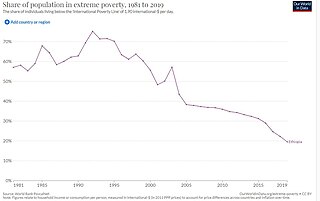
The African country of Ethiopia has made massive strides towards alleviating poverty since 2000 when it was assessed that their poverty rate was one of the greatest among all other countries. The country has made great strides in different areas of the Millennium Development Goals including eradicating various diseases and decreasing the rate of child mortality. Despite these improvements, poverty is still extremely high within the country. One of the leading factors in driving down poverty was the expansion of the agricultural sector. Poor farmers have been able to set higher food prices to increase their sales and revenue, but this expansion has come at a cost to the poorest citizens of the country, as they could not afford the higher priced food. One of the biggest challenges to alleviating this issue is changing the structure of Ethiopia's economy from an agricultural-based economy to a more industry-based economy. The current strategy for addressing poverty in Ethiopia is by building on existing government systems and development programs that are already in place within the country.
Hunger in Bangladesh is one of the major issues that affects the citizens of Bangladesh. The nation state of Bangladesh is one of the most densely populated countries in the world and home for more than 160 million people. It progresses immensely in the Human Development Index, particularly in the areas of literacy and life expectancy, but economic inequality has increased and about 32% of the population, that is 50 million people, still live in extreme poverty.
Long term aid to those in need creates a fear of having those provided with aid falling into the dependency theory. The rationale is that those who are benefiting will lose motivation to improve their lives on their own. Some may even work to worsen their condition in order to qualify for the aid. Additionally, one argument is that peripheral countries, such as Ethiopia, will not move out of needing aid because of the advanced economy's control. On average, Ethiopia has received 700,000 tons of food aid per year for the past 15 years. In rural Ethiopia, food aid has been provided for over three decades.
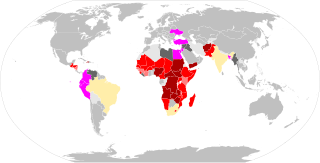
During the COVID-19 pandemic, food insecurity has intensified in many places – in the second quarter of 2020 there were multiple warnings of famine later in the year. In an early report, the Nongovernmental Organization (NGO) Oxfam-International talks about "economic devastation" while the lead-author of the UNU-WIDER report compared COVID-19 to a "poverty tsunami". Others talk about "complete destitution", "unprecedented crisis", "natural disaster", "threat of catastrophic global famine". The decision of WHO on 11 March 2020, to qualify COVID as a pandemic, that is "an epidemic occurring worldwide, or over a very wide area, crossing international boundaries and usually affecting a large number of people" also contributed to building this global-scale disaster narrative.
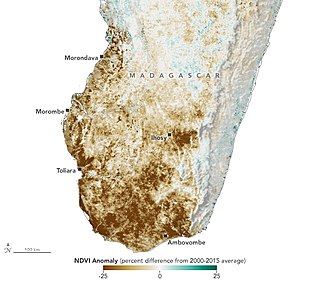
In mid-2021, a severe drought in southern Madagascar caused hundreds of thousands of people, with some estimating more than 1 million people including nearly 460,000 children, to suffer from food insecurity or famine. Some organizations have attributed the situation to the impact of climate change and the handling of the COVID-19 pandemic in the country.
















